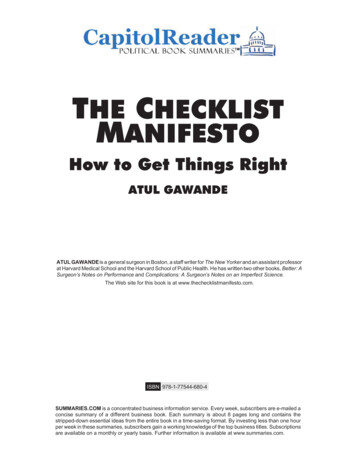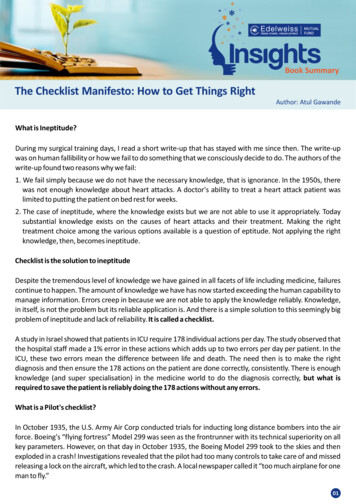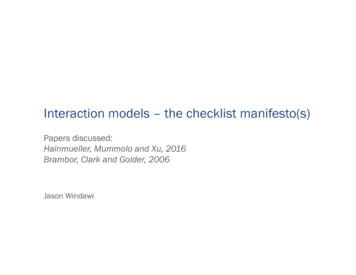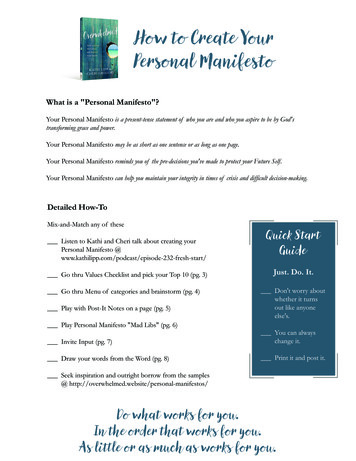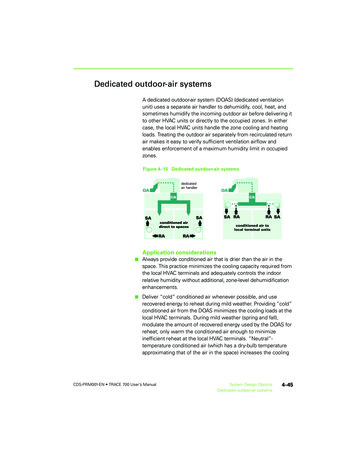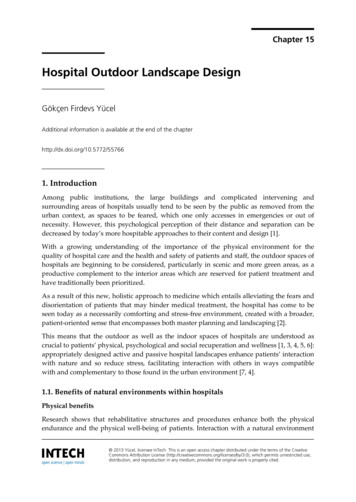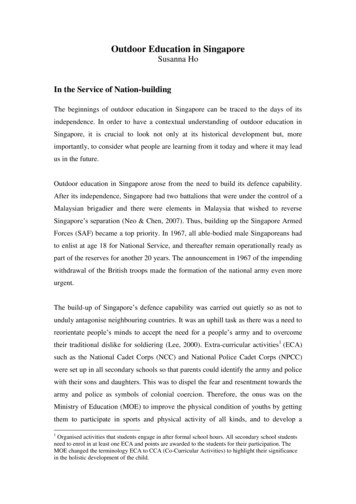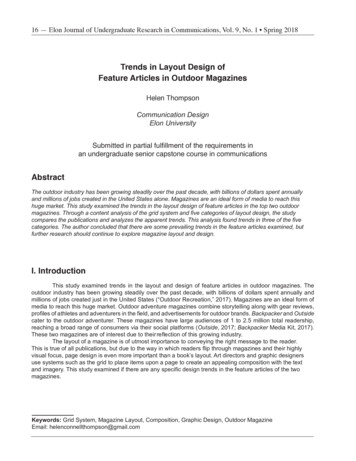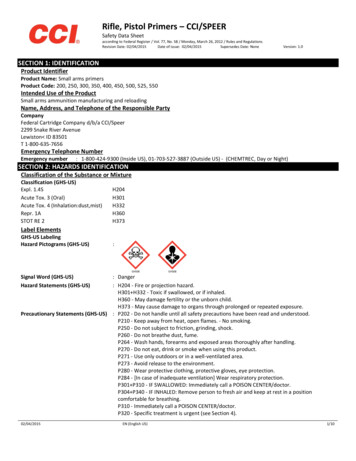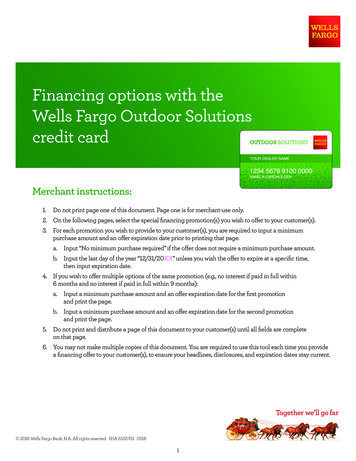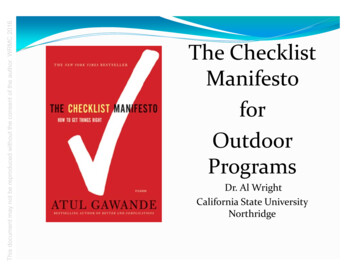
Transcription
This document may not be reproduced without the consent of the author. WRMC 2016The ChecklistManifestoforOutdoorProgramsDr. Al WrightCalifornia State UniversityNorthridge
This document may not be reproduced without the consent of the author. WRMC 2016Workshop Goals Introduce Gawande’s Checklist Manifesto book Review the Checklist approach Provide evidence of success in other fields Apply the Checklist approach to safety management inoutdoor programs Provide some examples already implemented Create and/or analyze some examples with you duringthe workshop
This document may not be reproduced without the consent of the author. WRMC 2016Presenter’s Disclaimers Checklist approach is not totally new to our industry The Checklist approach Still part of my learning curve Have implemented some examples in our outdoor SOPand believe there is significant potential in thisapproach
This document may not be reproduced without the consent of the author. WRMC 2016Safety Management Risk Management is a systemic approachgeared to protecting the total organization’sbest interests.– Organizational Survival & Protection Safety Management is a systematicapproach focused on the health and safetyof the program participant’s interests– People’s Survival & Protection
This document may not be reproduced without the consent of the author. WRMC 2016Classic Approaches to Safety Management # 1. Good Judgement of field instructorsGood judgment comes from experience!Good experience comes from poorjudgment.
This document may not be reproduced without the consent of the author. WRMC 2016Classic Approaches to Safety Management # 1. Good Judgement of field instructors Good Judgement is learned from direct personalexperience and technical skills sets Good Judgement is critical thinking skills Good Judgement is a knowledge base beyond yourpersonal experience (other’s stories and learning) Good Judgement is a knowledge & experience base of‘reading people’ and how attitudes & vitality affect safety “Thinking about safety”‐ Jim Udall – Camping Magazine, 1983
This document may not be reproduced without the consent of the author. WRMC 2016Classic Approaches to Safety Management Good Judgement approach to Safety The Protocols approach to Safety SOP – Standard Operating Proceduresor AKA Safety Protocols Policy and Procedures for Specific Activities PFD use/ Climb Site Management/ Etc. Policy and Procedures for All Activities Trip planning/ Weather/ Etc. Policy and Procedures for general anticipated conditions Medical Emergencies Lost Students
This document may not be reproduced without the consent of the author. WRMC 2016Classic Approaches to Safety Management # 1. Good Judgement approach to Safety # 2. The Protocols approach to Safety # 3. The Check List approach to Safety More than just protocols Integration of select protocols into the specific conductof an activity A checklist can be replicated across multiple staffresulting in less mistakes & a higher record of safety. A checklist is a systemic response to solve a complexproblem
This document may not be reproduced without the consent of the author. WRMC 2016What’s a Checklist: Atul Gawandehttps://www.youtube.com/watch?v L3QkaS249Bc
This document may not be reproduced without the consent of the author. WRMC 2016Guidelines for Building Checklists Gwande Summary (Video) – Need to Think in Systems Identify Problems /Recognize Success & Failure (data) Accidents? Near Misses? Build a Checklist Pause PointsCritical Items (Keep it Simple) Confront a new set of values Humility/ Teamwork/ Self‐reflection
This document may not be reproduced without the consent of the author. WRMC 2016What are our “operating rooms”? What are the routine but complexoutdoor settings where ‘safety checks’are/should happen and that couldbenefit from a Checklist? Activity management with risks?
This document may not be reproduced without the consent of the author. WRMC 2016Types of Checklists Do – Confirm Checklists Do the steps from memory and then pause to check Often a repeated behavior that becomes familiar E.g. A Pre‐flight Checklist Read ‐ Do Checklists Critical steps Often less experience with the situation Especially suited for emergency responses E.g. A ‘Engine on Fire’ on take off Often done as a ‘team’ – a “reader”; a “doer/checker”
This document may not be reproduced without the consent of the author. WRMC 2016Aviation’s use of emergency checklists?(Engine fire on take-off)https://www.youtube.com/watch?v H2KoNE6A5UY
This document may not be reproduced without the consent of the author. WRMC 2016What did you hear and see?
This document may not be reproduced without the consent of the author. WRMC 2016What are our ‘emergenciesin flight’? What situations are “not routine” butrequire a complex response when they dooccur?
This document may not be reproduced without the consent of the author. WRMC 2016An experience with SFF A little story . . . The Flight Safety Foundation sponsored thisinternational industry initiative to improve checklistprocedures for airline pilots confronting smoke, fire, orfumes. It also published the Smoke/Fire/Fumes Philosophyand Definitions, which was used to construct the SFFchecklist template. Here are the key components ofthis philosophy.
This document may not be reproduced without the consent of the author. WRMC 2016General Principles for SFF The entire crew must be part of the solution. For any smoke event, time is critical. The SFF checklist template does not replace alerted checklists (e.g.,cargo smoke) or address multiple events. Includes considerations to support decisions for immediate landing(e.g., overweight landing, tailwind landing, ditching). Systematically identifies and eliminates an unknown SFF source. At the beginning of an SFF event, the crew should consider all of thefollowing: Protecting themselves (e.g., oxygen masks, smoke goggles). Communication (e.g., crew, air traffic control). Diversion. Assessing the SFF situation and available resources.
This document may not be reproduced without the consent of the author. WRMC 2016Other topics to consider for SFF Source EliminationTiming for diversion/landingSmoke or fumes removalAdditional steps for source /aeromagazine/articles/qtr 01 09/article 03 2.html Take aways A checklist creation begins with big topic discussion ofguidelines and issues A checklist product ends with specific action steps
This document may not be reproduced without the consent of the author. WRMC 2016This image cannot currently be display ed.
This document may not be reproduced without the consent of the author. WRMC 2016Outdoor Programsan Example of a Checklist
This document may not be reproduced without the consent of the author. WRMC 2016The SHARK TestA Checklist Example: Ropes Course S ‐ Stuff (No loose stuff) H₂ ‐ Helmet & Harness (Proper fit) A – Attitude (Are your ready?) R2 – Rope(s) (Check from end to end) K – Karabiner (Squeeze Test)Do . . . Confirm
This document may not be reproduced without the consent of the author. WRMC 2016The SHARK TestA Checklist versus a Protocol Checklist is systemic and operational Implemented at a ‘pause’ point(s) Assumes implementation of previous training E.g. harness fit/ rope clear/ belay technique but doesnot describe them Assumes action steps are defined as a site specificprotocol and consistent with national standards What knots, what gear, what staff – Is SHARK a Read/Do or Do/Confirm? The strength of 2 person checklists
This document may not be reproduced without the consent of the author. WRMC 2016A few more tips on checklist design Location of the list Signs/ Flip Books/ First Aid Kit Cards Communication is critical component Important in complex environments Identify communication loops or confirmations Test the List Adapt Improve Implement
This document may not be reproduced without the consent of the author. WRMC 2016Outdoor Programs‐ another example ‐An emergency based checklist
This document may not be reproduced without the consent of the author. WRMC 2016Critical Incident Response – Medical Emergency Checklist 1. Do critical first aid Read – Do ChecklistABC ‐ Airway/ Breathing/ CirculationRapid Assessment – Necessary Responses2. EMS Activation if Critical Category If Urban – Dial 911 with Location Determined and Report of Condition If Wilderness – Assuming No Immediate Phone Accessa) Runners – 2 or 3 Together: Checkb) Route Review: Checkc) Gear Check Weather /Water/Food:Check Maps:Check Vehicle Keys: Check Phone Access : Check Incident Location Coordinates/Route: Check Medical Notes: Check d) Next Communication/ Reconnection e) Send Runners: (Reconnection/ Next Communication Set)
This document may not be reproduced without the consent of the author. WRMC 2016Medical Emergency Checklist: Ropes CourseCritical Medical Emergency Checklist at Ropes 1. Dial 911 Report brief medical summary Report location – Corner of Halsted Street and LindleyAvenue, Northridge Need of paramedic assistance ASAP 2. Provide immediate stabilization and ABC Do not move from fall injury Airway/Breathing/Circulation 3. Contact Campus Police Services Dispatch at 818‐677‐2111 to report the 911 call already placed.
This document may not be reproduced without the consent of the author. WRMC 2016Create A Checklist Group of 4‐8 people: Assign a Checklist Issue Part A Identify the guidelines that must be included Identify ‘critical steps or checks’ in danger of beingmissed. Is there evidence or data to confirm these should be inthe list National Standards/ Experiential Knowledge Actionable Steps – “specific response required for eachitem” Work On The List ( 7‐10 minutes)
This document may not be reproduced without the consent of the author. WRMC 2016Critique A Checklist Part B ‐ Review the Checklist Provided and Critique/Improve Were your ‘lists’ the same as those outlined here Ask the ‘pause point’ question Within the listWhen do we implement this list Is our list more a Read‐Do or a Do‐Confirm Checklist Where does the list reside? (Accessible) Read out loud? (Two Person Check) Will a mnemonic help? (Hands free Do‐Confirm Cklist) How will we test and adapt the list
This document may not be reproduced without the consent of the author. WRMC 2016Report your findings
This document may not be reproduced without the consent of the author. WRMC 2016
This document may not be reproduced without the consent of the author. WRMC 2016Critiques of Checklists Critique: Restrict freedom and creativity. Checklists are too rigid. Response: They liberate our brains to focus on the hard stuff,where problem solving, courage and creativity are needed most. Critique: Does not recognize staff’s ability, skill, and determination. Response: People make mistakes due to distraction or short termmemory limitations leaving critical steps out in a complex process. Critique: I don’t need a checklist because I’m already OCD. Response: Create a culture of teamwork (not self‐sufficiency) toreinforce a personal culture of discipline.
This document may not be reproduced without the consent of the author. WRMC 2016Final Questions and Resources Questions and Applications Dr. Atul Gawande , The Checklist Manifesto: How toGet Things Right (Paperback – 2011)
Workshop Goals Introduce Gawande’s Checklist Manifesto book Review the Checklist approach Provide evidence of success in other fields Apply the Checklist approach to safety management in outdoor programs Provide some examples already implemente
